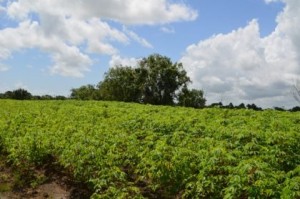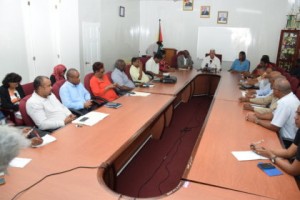The agriculture sector’s performance has been satisfactory despite the challenges that it has faced in 2016.
Minister of Agriculture Noel Holder hosted a press briefing today, in the Ministry’s Boardroom, Regent Road and Shiv Chanderpal Drive to update the media on the achievements of the various agencies under his ministry said, “By and large the sector in my opinion has not done too badly at all,” Minister Holder said.
The sector is made up of a number of subsectors namely rice, sugar, livestock, other crops, fisheries, hydrometeorological services, drainage and irrigation, and pesticides and toxic chemicals control. Minister Holder brought the media up-to-date on the sector’s achievements for the year. ‘

Aromatic rice just before harvesting. The Guyana Rice Development Board (GRDB) is intensifying efforts to produce this variety.
Rice
Minister Holder noted that this sector was a success amidst ever growing challenges in 2016. Some of the highs and lows of the sector included:
- Production down by 12.7 percent due to continued uncertainty of diversification and El Nino weather conditions.
- Markets in 35 countries have been secured for rice products.
- Increase in exports by one percent over 2015 at the end of October. However, due to the reduction in world market prices, the value of exports will decline over time.
- Diversifying sector through aromatic rice. About 12 varieties of specialty rice paddy under cultivation- In 2016, 300 acres of the aromatic rice variety was planted for the first crop and over 3,000 acres for the second crop.
- Government has been diligently employing technologies in an effort to reduce impact of severe weather conditions.
For the year 2017, the Guyana Rice Development Board (GRDB) will be working to address issues of production by offering farmers the necessary incentives to ensure they return to the land, Minister Holder pointed out. There will also be increased emphasis on value added production in 2017 for specialty rice varieties.
Sugar
Minister Holder pointed out that the sugar industry is no longer profitable as it is.
The Guyana Sugar Corporation (GUYSUCO) has been unable to self-reliantly secure the future of the industry. Government has been subsidising the operations of the industry in 2016 to the tune of $9B.
Some of the problems plaguing the industry include:
- Weather conditions- production for the year has been hampered by El Nino weather conditions. Final projected projections for 2016 are set at 183,000 tonnes with 194,355 tonnes expected to be carried over into 2017.
- Lack of investment in field and factory operations over the years resulting in downtime
- Power generation issues have led to increased usage of diesel fuel
- Poor liquidity and backed up suppliers’ payment
- Winding down of Wales factory
Despite these problems the industry has been able to:
- Supply value- added sugar to CARICOM customers.
- Sold over 10,000 tonnes of raw sugar to the European Union at an increased price over 2015.
- Tillage and replanting programme achieved 60 and 65 percent respectively
- Diversification of production at Wales estate; a rice project for the cultivation of seed paddy has commenced
- Integration of Wales workers into other estates
- Inter-ministerial committee to address reorganisation of the industry convened
Minister Holder noted that an invitation has been extended to the opposition and other stakeholders to determine the way forward for the troubled industry. “We have proposals, and we hope to discuss these with the opposition on Saturday…as well as GAWU, NAACIE and the Guyana Labour Union…and have it fleshed out… and get a feedback from them,” Minister Holder said.
Other Crops
The other crops’ sector is considered vital to the country’s economy. Through the National Agricultural Research and Extension Institute (NAREI), the Ministry of Agriculture’s accomplishments for 2016 include:
- Hosting of coconut festival. A coconut roadmap has been finalised to further catapult the commodity.
- $49M for the treatment of palms affected by red palm mite which benefitted more than 1,400 farmers
- Significant progress in managing black sigatoka disease affecting plantain/banana production
- Highest plantain production. In excess of 70,000 tonnes produced
- Introduction of new crop types: breadfruit, melons, sweet potatoes and sweet peppers
- Improved technologies to withstand weather impact
- Finalisation of expansion of agricultural station at Ebini
- Increased orchard crop production at Ebini
- 10 -acre farm at Hosororo to promote cultivation of spices, avocado and citrus
- Establishment of farm in Kato to demonstrate commercial agricultural production
Crop diversification is an ongoing exercise.
Livestock
Guyana is self-sufficient in poultry production. In 2016, production increased by 5 percent over 2015 to 32 million kilograms.
The Guyana Livestock Development Authority (GLDA) the agency within the ministry for the livestock sector has recorded the following achievements for 2016:
- Acquisition of poultry from Brazil to upgrade creole bird population. This will benefit hinterland residents
- Cattle farmers in several regions benefitted from GLDA’s bull rotation programme which has produced 3,000 animals of improved genetic material
- Duck hatchery programme continues to make significant contribution to the advancement of the local duck industry
- Duckling production projected to increase by 25 percent.
Fisheries
Minister Holder noted that the fisheries sector has established fundamental building blocks over the years. In 2016, the sector recorded positive growth of 11 percent.
Achievements included:
- Introduction of deep sea fishing in Exclusive Economic Zone
- The marine sub-sector has recorded 17,930 metric tonnes or an equivalent of $12.7 billion in exports
- Increased efforts to tackle illegal, unreported and unregulated fishing
The fishing industry is becoming the nation’s largest food industry and is a major contributor to Guyana’s economy. The industry is a very important sub-sector that continues to grow in economic importance in Guyana.
Drainage and Irrigation
The National Drainage and Irrigation Authority (NDIA) focused on improving and upgrading drainage and irrigation services countywide, thereby enhancing the competitiveness of the various sectors and improving productivity.
In 2016, the NDIA has:
- Commissioned a sluice at Bagotville, West Bank Demerara to drain 1,000 acres of residential and farm lands. Some 2,500 residents and farmers will benefit from the $85M project
- Drainage pumps at Trafalgar, Region Five were rehabilitated.
“The NDIA is expected to be more proactive in 2017 with the introduction of a dredge for clearing outfall channels, thereby significantly decreasing the possibility of flooding along the coastland,” Minister Holder noted.
Pesticides and Toxic Chemicals Control
The Pesticides and Toxic Chemicals Control Board (PTCCB) continued to execute its mandate through the management of pesticides and toxic chemicals in Guyana. During 2016, the monitoring of imports of chemicals saw:
- The registration and issuance of 1,137 licences for pesticides and toxic chemicals to date.
- There are now 165 licenced pesticide vendors in Guyana who are also involved in the management of restricted use of pesticides.
- Training is provided to educate pesticide users on proper storage practices. This programme has led to the establishment of a much needed private public partnership approach with industries.
- A Pest Control Operators Basic Proficiency Certification Programme was completed with 43 PCOs with millers being trained and certified.
- Confiscation of large quantities of unregistered pesticides from Regions Two, Three, Four and Five
- Launch of Pesticide Awareness Outreach programme in Region One targeting 17 villages in the Mabaruma area.
The Ministry of Agriculture has also been building the capacity of the Guyana School of Agriculture (GSA) to produce globally recognised agriculturists and support agricultural development through training and education awareness.








